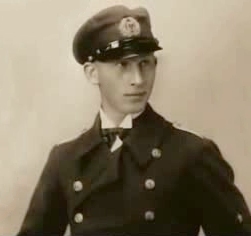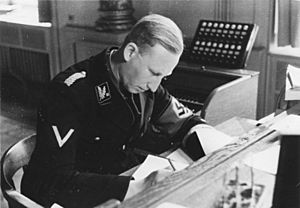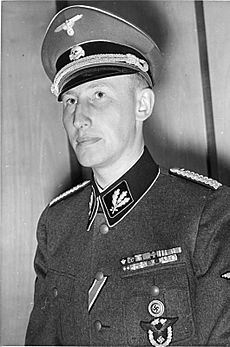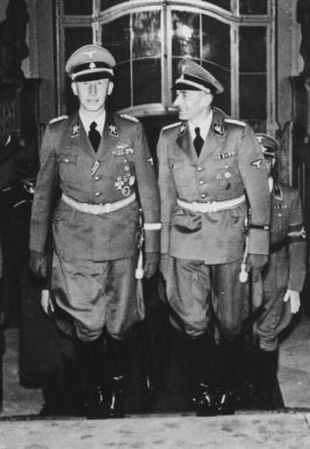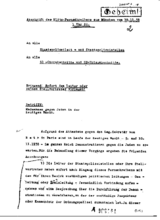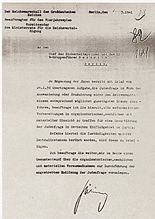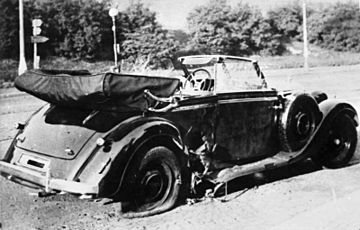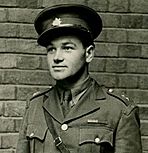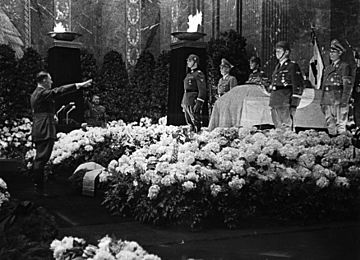Reinhard Heydrich facts for kids
Quick facts for kids
Reinhard Heydrich
|
|
|---|---|
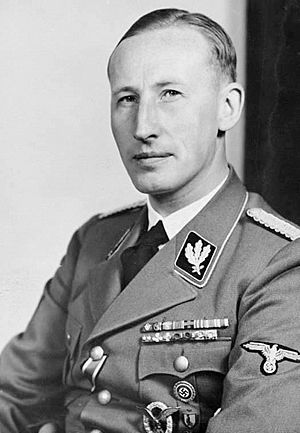
Heydrich in 1940
|
|
| Deputy Protector of Bohemia and Moravia | |
|
Acting Protector
|
|
| In office 29 September 1941 – 4 June 1942 |
|
| Appointed by | Adolf Hitler |
| Preceded by | Konstantin von Neurath (Protector until 24 August 1943) |
| Succeeded by | Kurt Daluege (Acting Protector) |
| Director of the Reich Security Main Office | |
| In office 27 September 1939 – 4 June 1942 |
|
| Appointed by | Heinrich Himmler |
| Preceded by | Office established |
| Succeeded by | Heinrich Himmler (acting) |
| President of Interpol | |
| In office 24 August 1940 – 4 June 1942 |
|
| Secretary-General | Oskar Dressler |
| Preceded by | Otto Steinhäusl |
| Succeeded by | Arthur Nebe |
| Director of the Gestapo | |
| In office 22 April 1934 – 27 September 1939 |
|
| Appointed by | Heinrich Himmler |
| Preceded by | Rudolf Diels |
| Succeeded by | Heinrich Müller |
| Personal details | |
| Born |
Reinhard Tristan Eugen Heydrich
7 March 1904 Halle an der Saale, Prussia, German Empire |
| Died | 4 June 1942 (aged 38) Prague-Libeň, Protectorate of Bohemia and Moravia (now Prague, Czech Republic) |
| Resting place | Invalidenfriedhof (Invalids' Cemetery), Berlin |
| Political party | Nazi Party |
| Spouse |
Lina von Osten
(m. 1931) |
| Children | 4 |
| Parents |
|
| Relatives | Heinz Heydrich (brother) |
| Signature |  |
| Nicknames |
|
| Military service | |
| Allegiance | |
| Branch/service |
|
| Years of service | 1922–1942 |
| Rank |
|
| Battles/wars | World War II |
| Awards | See service record section |
Reinhard Heydrich (born March 7, 1904 – died June 4, 1942) was a very powerful German official in the SS and police during the Nazi era. He was one of the main people who planned and carried out the Holocaust, which was the planned killing of millions of Jewish people.
Heydrich was the chief of the Reich Security Main Office, which included the secret police (Gestapo), the criminal police (Kripo), and the security service (SD). He was also the acting leader of Bohemia and Moravia, a part of Czechoslovakia that Germany had taken over. He led the International Criminal Police Commission, now known as Interpol. In January 1942, he led the Wannsee Conference, where plans were made for the "Final Solution to the Jewish question"—the forced removal and killing of all Jews in areas controlled by Germany.
Many historians see Heydrich as one of the darkest figures in the Nazi government. Adolf Hitler himself called him "the man with the iron heart." Heydrich helped create the Sicherheitsdienst (SD), an intelligence group that found and stopped people who resisted the Nazi Party. He also helped organize Kristallnacht in November 1938, which were attacks against Jewish people and their businesses across Germany. These attacks were a sign of the terrible events of the Holocaust to come.
When Heydrich arrived in Prague, he tried to crush any opposition to the Nazi rule. He did this by stopping Czech culture and by sending members of the Czech resistance to prison or killing them. He was also directly in charge of the Einsatzgruppen. These were special groups that followed the German armies and murdered more than two million people, including 1.3 million Jews.
Heydrich was badly hurt in Prague on May 27, 1942, during an attack called Operation Anthropoid. He was ambushed by Czech and Slovak soldiers who were sent by their government-in-exile to kill him. These soldiers were trained by the British. Heydrich died from his injuries a week later. In revenge, the Nazis falsely blamed the Czech and Slovak soldiers on the villages of Lidice and Ležáky. Both villages were completely destroyed.
Contents
Early Life and Education
Reinhard Heydrich was born in 1904 in Halle an der Saale, Germany. His father, Richard Bruno Heydrich, was a composer and opera singer. His mother, Elisabeth, taught piano. The family was well-known and had enough money.
Music was a big part of Heydrich's life. His father started a music school, and his mother taught there. Reinhard learned to play the piano and violin by age six. He loved the violin and was very talented.
Heydrich's father was a German nationalist who taught his children to be patriotic. The family home was strict. Reinhard was a bit weak and sickly when he was young, so his parents encouraged him to exercise. He became a strong swimmer and fencer. He was also very good at school, especially in science.
He was shy and sometimes bullied because of his high voice and rumors that he had Jewish family members. These rumors grew stronger after his uncle married a Hungarian Jew. However, his family got along well with the Jewish community. Many Jewish students attended his father's music school.
In 1918, World War I ended with Germany's defeat. In 1919, when Heydrich was 15, there was unrest in his hometown. He joined a volunteer group called the Freikorps. He was too young to fight, but he helped protect private property. This experience made him interested in German nationalist ideas and against communism. He also disliked the Treaty of Versailles, which was a peace treaty that Germany had to sign.
Germany faced severe economic problems after the war, including very high inflation. This made it hard for many people, including Heydrich's family, to afford things.
In 1922, Heydrich joined the German Navy (Reichsmarine). He liked the order and security the navy offered. He became a cadet at Kiel, a main naval base. Some of his fellow cadets wrongly thought he was Jewish. To fight these rumors, Heydrich said he had joined some nationalist groups.
He was promoted to senior midshipman in 1924 and went to officer training. In 1926, he became an ensign and worked as a signals officer on a battleship. He received good reviews from his leaders and got along well with his crew. In 1928, he was promoted to first lieutenant.
In December 1930, Heydrich met Lina von Osten at a ball, and they quickly got engaged. Lina was already a supporter of the Nazi Party. In early 1931, Heydrich was accused of breaking a promise to marry another woman. Because of this, Admiral Erich Raeder removed Heydrich from the navy in April 1931. Heydrich married Lina in December 1931.
Joining the SS
On May 31, 1931, Heydrich officially left the navy. The next day, he joined the Nazi Party in Hamburg. Six weeks later, on July 14, he joined the SS. His early joining date helped him avoid suspicion that he only joined for career reasons.
In 1931, Heinrich Himmler was setting up a new intelligence part of the SS. Himmler interviewed Heydrich and was very impressed with his ideas for an SS intelligence service. He hired Heydrich right away.
Heydrich took the job even though the pay was low at first. He liked the military-like and revolutionary nature of the work. As his power grew in the 1930s, his income also increased.
On August 1, 1931, Heydrich started his job as chief of the new intelligence service. He set up his office at the Nazi Party headquarters in Munich. By October, he had created a network of spies. They gathered information on thousands of people, which was stored on index cards. This information was sometimes used to blackmail people for political reasons. Himmler promoted Heydrich to SS-Sturmbannführer (major) in December.
In 1932, rumors about Heydrich's supposed Jewish ancestry spread. The Nazi Party's racial expert investigated Heydrich's family history and said he was "of German origin and free from any colored and Jewish blood." Heydrich also hired someone to further investigate and stop these rumors.
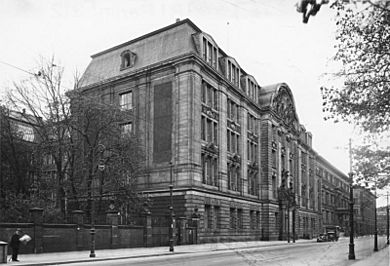
Leading the Gestapo and SD
In mid-1932, Himmler made Heydrich chief of the Sicherheitsdienst (SD), the security service. Heydrich's intelligence service became a powerful tool for terror and control. When Hitler gained power in Germany, Himmler and Heydrich wanted to control all police forces. They started in Bavaria. In 1933, Heydrich and his men took over the police headquarters in Munich. Himmler became the Munich police chief, and Heydrich led the political police.
In 1933, Hitler became the leader of Germany. The first concentration camps were set up to hold political opponents. By the end of the year, there were over fifty camps.
Hermann Göring started the Gestapo in 1933 as a police force in Prussia. In April 1934, Göring gave full control of the Gestapo to Himmler. It quickly became a tool of terror under the SS. Himmler made Heydrich the head of the Gestapo on April 22, 1934. The SD was declared the official Nazi intelligence service.
Crushing the SA
In April 1934, Hitler asked Heydrich and Himmler to gather information on Ernst Röhm, the leader of the Sturmabteilung (SA). The SA was a large Nazi paramilitary group. Hitler wanted to remove Röhm as a rival. Heydrich, Himmler, and others made lists of people to be killed.
On June 30, 1934, the SS and Gestapo arrested many people. This event was called the Night of the Long Knives. Up to 200 people were killed. The SA was then changed into a sports and training group.
With the SA out of the way, Heydrich made the Gestapo a feared organization. He improved his system of index cards, using color-coded cards for different types of offenders. The Gestapo could arrest people just because they suspected they might commit a crime. A law passed in 1936 gave the police the right to act outside normal legal rules. This led to widespread use of "protective custody," which meant people could be imprisoned without a trial. The courts could not interfere. People were arrested, sent to concentration camps, or killed without proper legal process.
In 1936, Heydrich left the Catholic Church. He believed the church's power was a danger to the state.
Uniting Police Forces
On June 17, 1936, all police forces in Germany were united under Himmler, who was appointed Chief of German Police by Hitler. This made Himmler and Heydrich very powerful in Germany's internal government. Himmler divided the police into two groups: the Ordnungspolizei (Order Police), which included uniformed and city police, and the Sicherheitspolizei (Security Police; SiPo), which included the Gestapo and criminal police (Kripo). Heydrich led the SiPo and SD.
Heydrich helped organize the 1936 Summer Olympics in Berlin. These games were used to promote Nazi ideas. Anti-Jewish violence was stopped during the games. For his work, Heydrich received the German Olympic Games Decoration.
In January 1937, Heydrich ordered the SD to secretly collect public opinion. Then, the Gestapo would search homes, arrest people, and question them, controlling what people thought and said. In February 1938, when Austria resisted joining Germany, Heydrich increased pressure by organizing Nazi protests. On March 12, Hitler declared Austria's unification with Germany.
In mid-1939, Heydrich created a foundation to buy property for the SS and Security Police. One of these properties, the Wannsee Villa, was where the Wannsee Conference took place on January 20, 1942. Heydrich led this meeting. At Wannsee, top Nazi officials made formal plans to remove and kill all Jews in German-controlled areas.
On September 27, 1939, the SD and SiPo were combined into the new Reich Security Main Office (RSHA), which Heydrich led. He also became the president of Interpol on August 24, 1940, and its headquarters moved to Berlin. He was promoted to SS-Obergruppenführer und General der Polizei on September 24, 1941.
Red Army Purges
In 1936, Heydrich heard that a high-ranking Soviet officer was planning to overthrow Joseph Stalin. Heydrich saw this as a chance to hurt the Soviet Army. He talked to Himmler and Hitler, who approved his plan. However, the "information" Heydrich received was actually false information planted by Stalin himself. Stalin wanted to justify his own plans to remove high-ranking officers from the Red Army.
Heydrich's SD created fake documents and letters that made it look like Soviet generals were plotting against Stalin. These fake documents were given to the Soviet secret police. This led to the Great Purge of the Red Army, where many officers were killed or removed by Stalin.
Night-and-Fog Decree
By late 1940, German armies had taken over most of Western Europe. The next year, Heydrich's SD was given the job of carrying out the Nacht und Nebel (Night-and-Fog) decree. This decree ordered that "persons endangering German security" be arrested secretly, "under the cover of night and fog." People disappeared without a trace, and no one was told where they were or what happened to them. The exact number of people who vanished under this decree is not known, but it is thought to be around 7,000.
Policies Against Poles
Heydrich created a special Gestapo unit to help with the ethnic cleansing of Poles in "Operation Tannenberg" and the Intelligenzaktion. These were code names for actions aimed at killing Polish people during Germany's occupation of Poland. In these operations in 1939–1940, about 100,000 people were murdered. About 61,000 of them were Polish intellectuals, like scholars, priests, and former officers.
Acting Protector of Bohemia and Moravia
On September 27, 1941, Heydrich was made Deputy Reich Protector of the Protectorate of Bohemia and Moravia. This was the part of Czechoslovakia that Germany had taken over in 1939. The previous leader was sent away because Hitler and Heydrich felt he was too "soft" on the Czechs. Heydrich wanted to "Germanize the Czech vermin," meaning he wanted to make the Czech people more German.
Heydrich came to Prague to enforce Nazi policies, fight resistance, and keep up the production of Czech motors and weapons, which were important for the German war effort. He saw the area as a German stronghold.
Heydrich started his rule by terrifying the people. He declared martial law, and 142 people were killed within five days of his arrival. Most of them were resistance members who had already been captured. By February 1942, between 4,000 and 5,000 people were arrested, and 400 to 500 were killed. Those not killed were sent to Mauthausen-Gusen concentration camp, where very few Czech prisoners survived.
Heydrich's harsh policies quickly earned him the nickname "the Butcher of Prague." The Czechs refer to these reprisals as the Heydrichiáda.
Heydrich used both harsh and seemingly kind methods. He reorganized labor and used equipment from a Czech gymnastics group to hold events for workers. Food rations and free shoes were given out, pensions increased, and for a time, free Saturdays were introduced. Unemployment insurance was also started. However, he severely punished anyone involved in the black market or resistance, calling them "economic criminals."
Despite these public displays, Heydrich privately stated his goal: "This entire area will one day be definitely German, and the Czechs have nothing to expect here." He planned for up to two-thirds of the Czech population to be moved to Russia or killed after Germany won the war.
Heydrich was essentially the military ruler of Bohemia and Moravia. He often drove alone in an open-roof car, showing his confidence in his control. By October 3, 1941, Czechoslovak military intelligence in London decided to kill Heydrich.
Role in the Holocaust
Historians consider Heydrich one of the most feared members of the Nazi leadership. Hitler called him "the man with the iron heart." He was a key planner of the Holocaust during the early war years. He reported directly to Hitler, Göring, and Himmler on all matters related to the forced removal, imprisonment, and killing of Jews.
Heydrich was one of the organizers of Kristallnacht, a series of violent attacks against Jews across Germany on the night of November 9–10, 1938. Heydrich sent a telegram that night, helping to coordinate the attacks. He allowed the burning and destruction of Jewish businesses and synagogues. He also ordered the arrest of "as many Jews—especially wealthy Jews—as can be accommodated in existing detention facilities." Twenty thousand Jews were sent to concentration camps in the days that followed. Historians see Kristallnacht as the beginning of the Holocaust.
When Hitler needed an excuse to invade Poland in 1939, Himmler, Heydrich, and Heinrich Müller planned a fake attack called Operation Himmler. It involved a staged attack on a German radio station on August 31, 1939. Heydrich planned this and visited the site. German troops, dressed in Polish uniforms, carried out several attacks along the border. Hitler used this fake event as his reason to invade.
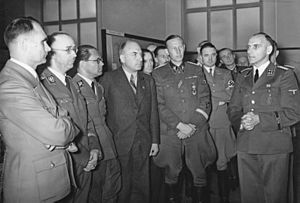
On Himmler's orders, Heydrich created the Einsatzgruppen (task forces). These groups followed the German armies at the start of World War II. On September 21, 1939, Heydrich sent out a message with instructions to gather Jewish people and place them into ghettos. He also ordered a census and promoted plans to take over Jewish-owned businesses. The Einsatzgruppen units went into Poland to carry out these plans. Historians estimate that between 1941 and 1945, the Einsatzgruppen and related groups murdered more than two million people, including 1.3 million Jews.
On November 29, 1939, Heydrich issued a cable about the "Evacuation of New Eastern Provinces," detailing the forced removal of people by railway to concentration camps. In May 1941, Heydrich made rules with Eduard Wagner for the upcoming invasion of the Soviet Union. These rules made sure that the Einsatzgruppen and the army would work together to murder Soviet Jews.
On October 10, 1941, Heydrich was the senior officer at a "Final Solution" meeting in Prague. They discussed sending 50,000 Jews from Bohemia and Moravia to ghettos in Minsk and Riga. Heydrich was key in carrying out these plans. They also planned to take 5,000 Jews from Prague and hand them over to the Einsatzgruppen. This led to the building of the Theresienstadt Ghetto, where 33,000 people would die. In 1941, Himmler put Heydrich in charge of moving 60,000 Jews from Germany and Czechoslovakia to the Łódź Ghetto in Poland.
On July 31, 1941, Hermann Göring gave Heydrich written permission to get other government departments to cooperate in carrying out a "Final Solution to the Jewish question" in German-controlled areas. On January 20, 1942, Heydrich led the Wannsee Conference to discuss how to put this plan into action.
Death
The Czechoslovak government-in-exile in London decided to kill Heydrich. Jan Kubiš and Jozef Gabčík were chosen for the mission. They were trained by the British Special Operations Executive (SOE). On December 28, 1941, they parachuted into Czechoslovakia and hid, preparing for the mission.
On May 27, 1942, Heydrich was on his way to meet Hitler in Berlin. His car had to slow down at a sharp turn in Prague. As his car slowed, Gabčík tried to shoot him with a submachine gun, but it jammed. Heydrich stopped his car and tried to confront Gabčík. Kubiš, who Heydrich hadn't seen, threw a converted anti-tank mine at the car. The explosion badly wounded Heydrich, causing severe injuries to his diaphragm, spleen, and a lung.
A Czech woman helped Heydrich and flagged down a delivery van. He was taken to Bulovka Hospital. Himmler ordered a doctor to fly to Prague to take care of him. Heydrich seemed to be recovering, but on June 3, he fell into a coma. He died on June 4, 1942, at 38 years old. An autopsy showed he died from an infection.
Funeral and Aftermath
After a large funeral in Prague on June 7, 1942, Heydrich's coffin was sent by train to Berlin. A second ceremony was held there on June 9. Himmler gave a speech. Hitler attended and placed Heydrich's awards on his funeral pillow.
Heydrich was buried in Berlin's Invalidenfriedhof, a military cemetery. His exact burial spot is no longer known. A temporary wooden marker disappeared in 1945 and was never replaced. This was done so his grave would not become a meeting place for Neo-Nazis.
Heydrich's widow, Lina, fought in court to receive a pension. She won in 1956 and 1959 and was given a large pension because her husband was a German general killed in action. The government had first refused because of his role in the Holocaust. Lina wrote a book about her life with Heydrich. She died in 1985.
Service Record
Heydrich's time in the SS included quick promotions and combat service. In 11 years, he rose from a private to a full general. He was also a major in the Luftwaffe, flying nearly 100 combat missions.
He started training as a pilot in 1935. Himmler at first did not want Heydrich to fly combat missions, but later allowed it. Heydrich flew with a fighter squadron in Norway in 1940. He returned to Berlin after crashing his plane during takeoff.
On July 20, 1941, Heydrich rejoined his fighter squadron during the invasion of the Soviet Union. His plane was hit by Soviet anti-aircraft fire on July 22, and he had to land in enemy territory. He avoided capture and was rescued by a German patrol. This was his last combat mission.
Heydrich received many Nazi and military awards. These included the German Order, the Blood Order, the Golden Party Badge, the Luftwaffe Pilot's Badge, and the Iron Cross First and Second Classes.
See also
 In Spanish: Reinhard Heydrich para niños
In Spanish: Reinhard Heydrich para niños


